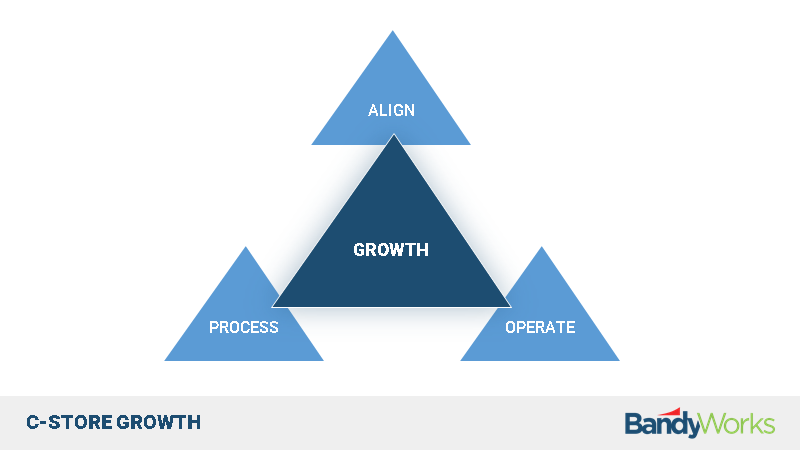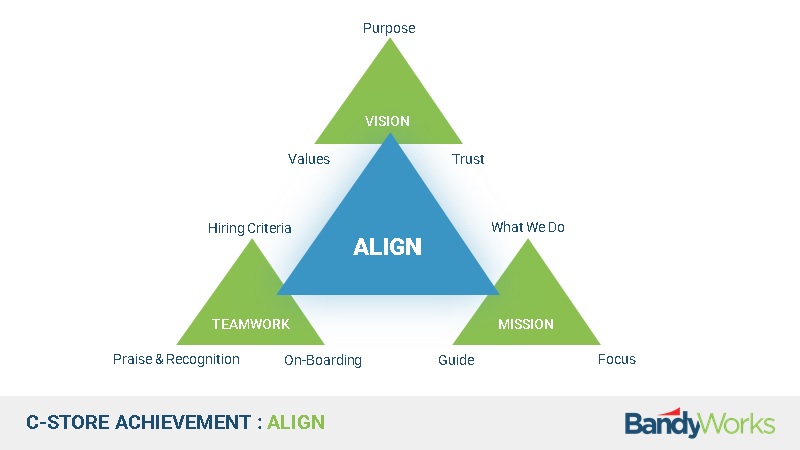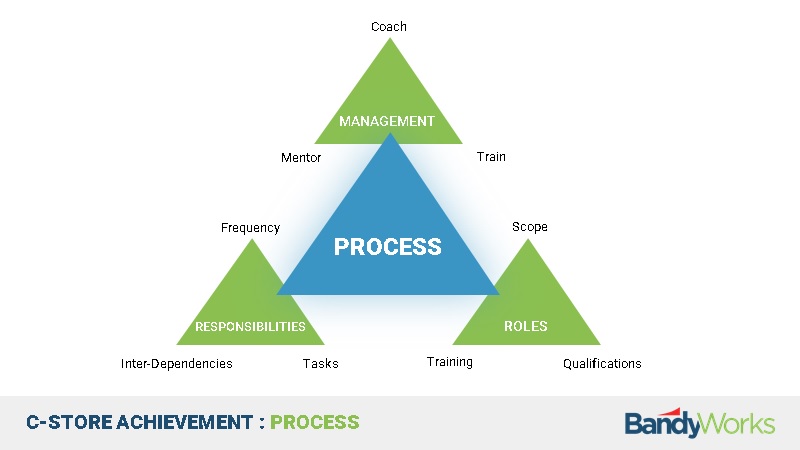
July 16, 2023
There are three main aspects of c-store operations ROI. C-Store operations have a virtually unlimited capacity to grow and attain on-going improvement. These results are evident with successful chains such as Casey’s, Kwik Trip, Wawa, Sheetz, and others.  They show the power of great businesses that have both a strong operational system and the ability to replicate and scale the operations. These companies not only have a powerful vision, mission, culture and brand, they also have the build to maintain and grow it organically.
They show the power of great businesses that have both a strong operational system and the ability to replicate and scale the operations. These companies not only have a powerful vision, mission, culture and brand, they also have the build to maintain and grow it organically.
That is, operational strength also means adding new services such as food and delivery, adding innovative products and services, and expanding the customer value in terms of frequency and volume. Finally, they know how to recruit, hire and on-board the right staff from the entry level all the way up into the highest management positions.
1. Alignment Engages Operations
 Many start with alignment as the foundation of c-store operations. Of course, knowing your purpose is the key to having alignment. Simon Sinek refers to purpose as the ‘Why’ of the organization. Knowing the purpose makes all subsequent decisions easier. What gets done, how it occurs, and what we choose to do first is based on our belief in achieving our vision.
Many start with alignment as the foundation of c-store operations. Of course, knowing your purpose is the key to having alignment. Simon Sinek refers to purpose as the ‘Why’ of the organization. Knowing the purpose makes all subsequent decisions easier. What gets done, how it occurs, and what we choose to do first is based on our belief in achieving our vision.
A clear vision will include values that are real. Everyone experiences the culture of a company and knows its authenticity. Real values applied to a genuine mission builds trust. The clarity of purpose make hiring simpler both for the employee and the employer. Building a great brand and delivering a great customer experience happens in the store between people. How hiring is done and how the on-boarding is delivered determines the way cashiers (and all staff) perform their job. It directly impacts the customer experience. Greg Ehrlich, President of FriendShip Stores, simplifies his operational direction. He lists ‘culture, brand and data analytics’ as the chain’s three strategic priorities. In essence, the purpose (Vision) of the company, when executed well as part of the operations, can be tracked, managed, and mastered.
2. Process Is the Blue-Print
Boring. Tedious. Demanding. … Simple. Effective. Profitable. The core of operations is the process. Making it clear, training thoroughly, and taking the time to ensure it is understood makes the operations consistent and scalable. Ironically, having a precise way to do work can increase innovation and improvements. By making the routine straightforward and ensure job expectations are met, things go better. Successful, non-stressed staff are more free and confident to provide new ideas and make changes. In fact, the best cultures have processes that assume improvement through on-going changes.
Most operations assume some level of failure or unusual activities. As work becomes standardized, results are consistent and there is time for thinking, training and brainstorming. New things can be added, old things can be made better. Having a good set of results provides the extra time, money and skillsets to do even more. Good things follow from good work.
training and brainstorming. New things can be added, old things can be made better. Having a good set of results provides the extra time, money and skillsets to do even more. Good things follow from good work.
Having the process in place ensures the essential priorities are met, the results are measured for quality and ‘profits’ can then be applied to grow careers, services, stores and customer traffic. Everyone wins when work goes as planned.
3. C-Store Operations in Action
Creating return is the natural outcome of operations. Having a goal provides motivation to track and adjust how the work is done. Managers are responsible to ensure the alignment is in place, the processes are understood, and the results are tracked. ![]() Operations are the management effort to adjust work to the desired team outcomes. It includes process follow-up, results tracking, and alignment coaching.
Operations are the management effort to adjust work to the desired team outcomes. It includes process follow-up, results tracking, and alignment coaching.
Follow Up Adjusts C-Store Operations
Many consider follow up to be the definition of accountability. Certainly, checking in and ensure staff perform their jobs, fulfill their requirements for frequency and quality are essential jobs. Obviously, not every job is done perfectly. This part of the job can seem stressful to both sides of the follow up conversation. However, when done well with alignment to the goals, and fit with the vision; it can be the most rewarding and satisfying part of the job.
No one expects a team to work without making mistakes. Who could be held accountable to the standard of perfection? Delivering bad news can be painful. However, understanding we are not trying to be perfect but rather to keep getting better, the feedback loop changes from negative to positive. When viewed as a normal part of the job, follow up can be the most satisfying and enjoyable part of work for both the ‘boss’ and the worker. Follow up, then is where the three aspects of c-store operations ROI come together.
Recognition and Insights Are Feedback Essentials
When a team is working towards a goal and gets proper recognition for jobs done well, new skills mastered and progress in their work, it is much more likely that feedback can be viewed as a natural part of the job. Having a path of growth and knowing where one is on that path can change a ‘nag’ into a normal part of teaching or coaching. Focusing on the goal and providing accurate and useful feedback allows everyone to be part of problem solving. That is, all work is team work.
One of the overlooked areas for maximum operational improvement, is the team feedback loop. Listening to challenges, and soliciting new ideas not only helps to make the job better, but increases buy-in and job satisfaction. Managers that remain open to ideas, listen to the ‘real’ work situation, and seek out staff ideas are much more likely to have their guidance accepted. Who else, understands a work challenge than the one that is doing the work every day?
Coaching Improves and Maximizes C-Store Operations
Once skills are known, management follow up naturally shifts to coaching and mentoring. Improvements occur as work is mastered. Hence, just finding ways to help improve attitudes, techniques and priorities can make the same labor yield higher results. Of course, using staff goals as the motivation makes it more likely to have buy-in and willingness. While it is nice to have a great company goal, staff are much more motivated with their personal goals. When personal goals are aligned to company goals, change and effort become easier.
Tracking Measures C-Stores Operations
Sales, labor, customers, products all have counts. Counts provides insights into activity. These counts represent a measure of operational activity. Profits measure overall performance. Of course, maximizing returns means generating profits. Looking at long term value rather than just the immediate returns can produce the maximum store value.
Measurements are useful for showing trends. Trends require some level of historical data as well as knowing what needs to be measured. Measurements can evolve to track those things that provide insights into current behaviors.![]()
For operations, it is useful find those measurements that predict the desired outcomes. Of course, daily sales show how monthly and long-term sales are going. Additionally, other counts like customer traffic, basket size and operational activity measurements are also available. Knowing when customers arrive and what they want during different parts of the day provides adequate staffing to serve them when they are present.
Knowing what is needed to be done to be ready is another level of operational measurements. Cleaning, stocking, ordering and training all take time. Having staff and services ready means acting before the customers want to buy. Knowing how much product to have, how many staff are needed and how well the services are delivered provide insights that enable adjustments.
Where to Start to Maximize C-Store ROI
Unless a store is brand new with no operational history, operational ROI is already in place. Building alignment, creating or improving processes and fine-tuning fulfillment are all possibilities. Assessing where you are and what needs improvement helps to find the first area of focus. Like Yogi Berra famously stated “when you come to the fork in the road, take it.” That is, get started if you are not sure what is needed. As you review and work the operations improvement process the areas that need attention will naturally come to light.
With operations, all areas impact results. If tracking is already in place then identify the strengths that can be maximized first. Next assess if there are weaknesses that are having a large negative impact on the operational strengths.
As an alternative many companies start with alignment. Having a compelling vision can drive operations. All organizations have a purpose and mission. They may not be well understood and they may not be matching to the store staff. Spending time to clarify your goals and ensure staff want to participate can yield amazing effort. Not everyone will fit to an organization. Choosing well and supporting the team is essential to alignment.
A third area is to work on operational procedures. Processes that make the job simple and provide great service make work outcomes better. Having teams create or improve process can be part of the culture that keeps teams engaged and growing.
Being consistent, looking to grow, opening the culture to new ideas while staying true to the mission establishes a company that can adapt, grow and add value over time. A chain is its people and having them aligned makes the potential return nearly unlimited.
What is Possible?
Naturally, the question to consider as leaders prioritize investments must consider maximizing returns. Growing c-store chains must apply their resource of money, time and talent as a scarce resource. During Joe Sheetz’ time leading, he argued that he could grow best by reinvesting in existing stores. GPM has proven that acquiring existing chains and bringing their central office functions in-house but keeping the on-going brand and operations was a successful growth approach. Wawa has proven that building new stores and rolling their operations allows for profitable and long-term growth. Single store owners, know they can add new services, hire more staff and expand a facility beyond what they can do on their own.
Different Choices
All of these strategies work and typically any operator with more than one store will use all the approaches at some point in their history. For all approaches, however, operational integrity is essential. Growth strategies, both for sales and profit, require strong operations. Without a consistent and clear approach to success, organizations cannot sustain profitability and keep the stores running.
In summary, including the operational impact for all growth is mandatory. No growth occurs unless the store can run and fit into the chain. Given the operational impact, growth companies know they can always expand either profits, stores or sales by improving the operations. Every marketing plan, each new store, all the new food offerings demand cashiers and store staff to deliver and produce. No one executes perfectly, but we can keep learning and growing. Best of all, improvement yields more improvements. Making things better is fun and satisfying and maximizes both the operational ROI and the overall chain value.